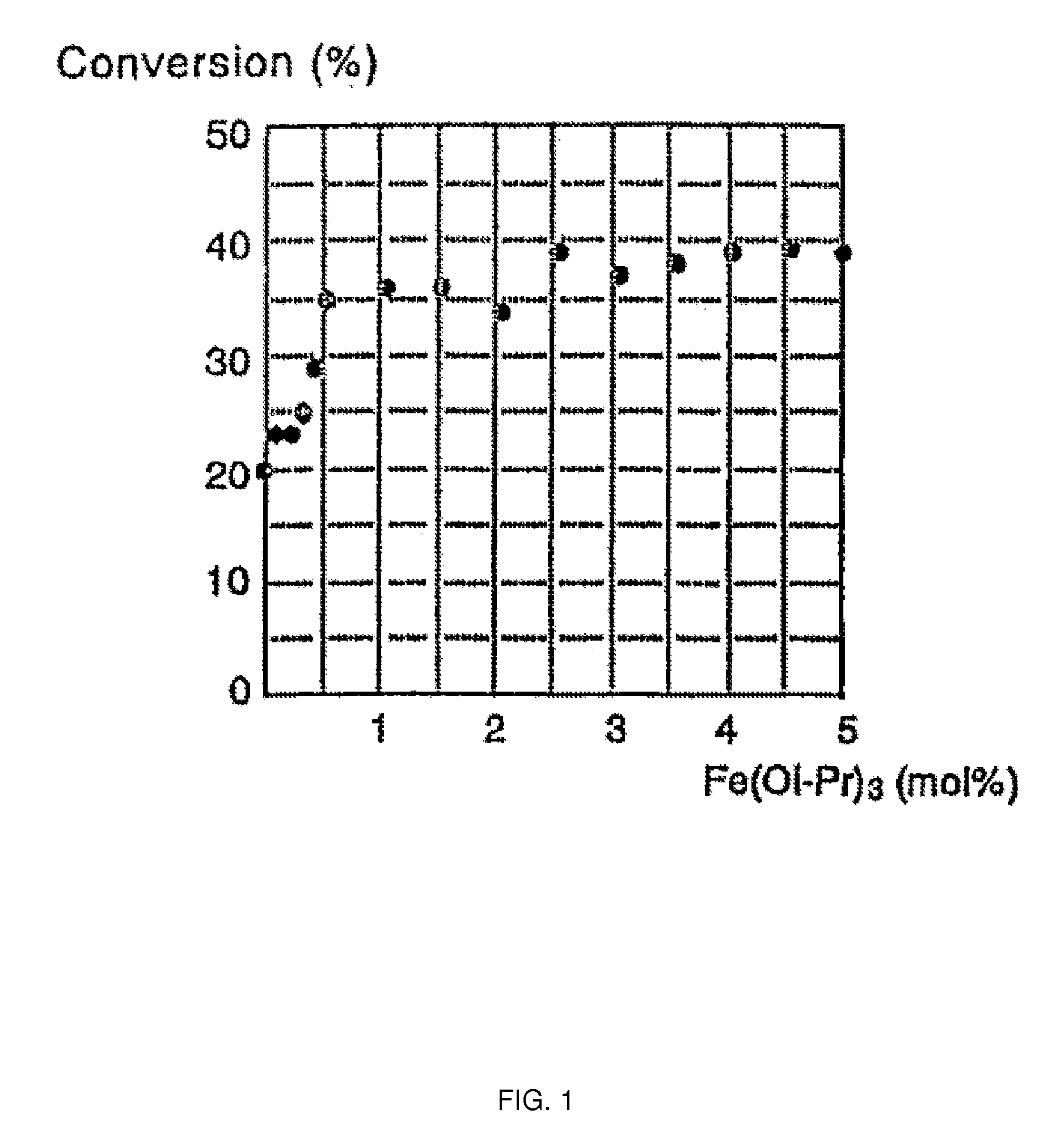Method for producing ester condensed product
a technology of ester condensate and catalyst, which is applied in the direction of organic compound/hydride/coordination complex catalyst, physical/chemical process catalyst, organic chemistry, etc., can solve the problems of inability to efficiently prepare ester, inability to induce excellent activity of 3 mol % of these additives for performing the reaction in place of zr(iv) salt, and inability to achieve excellent activity, good results
- Summary
- Abstract
- Description
- Claims
- Application Information
AI Technical Summary
Problems solved by technology
Method used
Image
Examples
example 1
[0034]3 mol % of Zr(OH)x(OAc)y(x+y=4) and 2 mol % of various metal salts were added into heptane solution of equimolar mixture of 4-phenylbutyric acid and cyclododecanol in a reaction container, and the mixture was heated to reflux for 6 hours, while the temperature of the oil bath was set to 120° C. The generated water was removed from the reaction system using a Dean-Stark fractionating apparatus. Then, the objective ester was obtained from the organic layer by extraction with diethyl ether. The ester was purified by distillation or using a silica gel column chromatography. The obtained ester conversion is shown in Table 1.
TABLE 1CatalystAdditiveConversion (%)1Zr(OH)x(OAc)y—322Ga(Oi-Pr)3—143Fe(Oi-Pr)3—144Ti(Oi-Pr)4—325Zr(OH)x(OAc)yZr(OH)x(OAc)y476Zr(OH)x(OAc)yGa(Oi-Pr)3627Zr(OH)x(OAc)yFe(Oi-Pr)3768Zr(OH)x(OAc)yTi(Oi-Pr)449
[0035]The result shows that catalytic activity was improved by adding gallium(III) isopropoxide (Ga(Oi-Pr)3), iron(II) isopropoxide (Fe(Oi-Pr)3) to Zr(OH)x(OAc)y...
example 2
[0036]5 mmol of 2-tetrahydrofuroic acid, 5 mmol of benzyl alcohol, 0.5 mol % of zirconium(IV) isoproxide (Zr(Oi-Pr)4), 2 mol % of iron(III) isopropoxide (Fe(Oi-Pr)3), and 2.5 ml of octane were added into a reaction container, and the mixture was heated to reflux for 6 hours, while the temperature of the oil bath was set to 140° C. The generated water was removed from the reaction system using a Dean-Stark fractionating apparatus. After the reaction, resultant was once cooled to room temperature and 1 set of 1 M hydrochloric acid solution was added thereto, and the solution was stirred for 30 min at room temperature. Then, the objective ester was obtained from the organic layer by extraction with diethyl ether. The ester was purified by distillation or by using silica gel column chromatography. The yield was 99% or more.
example 3
[0037]Reaction was performed with iron(III) isopropoxide(Fe(Oi-Pr)3) in the same manner as Example 1 but the adding amount to 10 mol % of zirconium(IV) isoproxide (Zr(Oi-Pr)4) was changed and the temperature of the oil bath and the reaction time were set to 115° C. and 2 hours, respectively. The ester conversion is shown in Table 2 and FIG. 1.
TABLE 2Fe(Oi-Pr)3Conversion (%)0200.1230.2230.3250.4290.5351.0361.5362.0342.5393.0373.5384.0394.5395.039
[0038]The result shows that 0.5 mol % or more of iron(III) isopropoxide (Fe(Oi-Pr)3) to 10 mol % of zirconium(IV) isoproxide (Zr(Oi-Pr)4) is required in order to optimize the adding effect of iron for the purpose of improving the catalytic activity.
PUM
| Property | Measurement | Unit |
|---|---|---|
| temperature | aaaaa | aaaaa |
| molar ratio | aaaaa | aaaaa |
| molar ratio | aaaaa | aaaaa |
Abstract
Description
Claims
Application Information
 Login to View More
Login to View More - R&D
- Intellectual Property
- Life Sciences
- Materials
- Tech Scout
- Unparalleled Data Quality
- Higher Quality Content
- 60% Fewer Hallucinations
Browse by: Latest US Patents, China's latest patents, Technical Efficacy Thesaurus, Application Domain, Technology Topic, Popular Technical Reports.
© 2025 PatSnap. All rights reserved.Legal|Privacy policy|Modern Slavery Act Transparency Statement|Sitemap|About US| Contact US: help@patsnap.com

